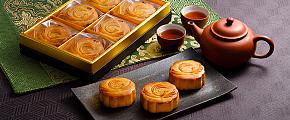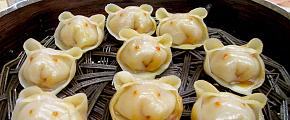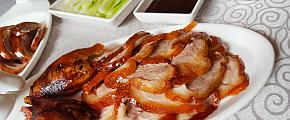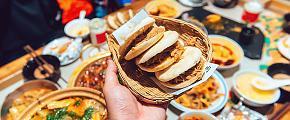Drinks and Snacks of China - Chafing Dish, Shashlick, Lotus roots
Chafing Dish (Huoguo)
The chafing dish is a favorite with the northern Chinese, especially in winter. The main ingredient for this dish is usually mutton; however, beef, fish, or prawn may also be used. It is eaten with vermicelli, fresh vegetables, and sometimes dumplings. The Chinese hot pot is different from the Western chafing dish in that its soup container is built around (instead of over) its belly-like heater. It is usually made of copper or brass, but may also be available in aluminum and burnt clay. It is called a "Mongolian pot" by some Westerners perhaps because of its association with mutton from Inner Mongolia. The preparation of the chafing dish is simple: first, water (preferably boiling water) is poured into the container, and then burning charcoal is filled into the heater from the top of the small chimney. When the water is brought to the boil again, the meat or fish slices may be put in, little by little, by the diners themselves.
 Chafing Dish (Huoguo)
Chafing Dish (Huoguo)
After a while, they may be taken out with chopsticks and, before eating, dipped in a sauce prepared in advance. The meat for this dish must be from the tenderest parts of the animal. Take mutton, the commonly used meat, for example.
From a sheep of over twenty kilograms, only six to seven kilograms are fit to be eaten this way. Each kilogram is cut into at least 120 slices. They must be paper-thin in order to be cooked instantly in the boiling water and remain tender when taken out.
Along with the mutton slices, fresh vegetables and vermicelli are put into the pot, to be boiled and eaten. The dumplings, if any. usually come last. The sauce in which the cooked slices are dipped is very important. It is a mixture of sesame paste (Zhimajiang), sesame oil (mayou), shrimp sauce (Luxiayou), soya sauce (jiangyou), chili oil (layou), chive flower sauce (Jiucaihua), fermented bean curd sauce, cooking wine, and parsley. And sweetened solutions of garlic may be eaten for added relish.
Have a Hot Pot Dinner in Chongqing or Chengdu in Sichuan Province
Shashlick (Yangrouchuan)
The shashlick is an Arab snack very popular in the north and northwest of China, where there is a sizable Muslim population. May vendors are seen making them on street corners, especially in Xi'an and the cities & towns of the Xinjiang Uygur Autonomous Region. Xian is famous for its food in China. It is made of lean mutton cut into slices.
These are stuck one after another on iron skewers, which are then arranged closely on a trough-like burner and grilled over a charcoal fire. When the mutton oozes juice, salt, chili, and aniseed powders are sprinkled on and the shashlicks are ready to eat. Served at a formal dinner, they are made in a more refined way, for example, coated with sesame seeds to enhance the taste. The shashlick is known in English under various other names and spellings: shashlik, kabob, habab, kebab, kebob, and cabob, among others.
 Shashlick (Yangrouchuan)
Shashlick (Yangrouchuan)
Cake Particles in Mutton Soup (Yangrou Paomo)
Soaking cake particles in mutton soup first appeared in the pastureland in northwest China. Today it has become a special snack of Xi'an. Chunks of mutton are washed and sliced into pieces and boiled with scallion, ginger, wild pepper, star anise seed, cumin, and cinnamon. Baked wheaten cakes are then torn with a hand into particles the size of soybeans and placed in a bowl. Mutton slices are then added to the torn cake before the mutton soup is ladled into the bowl, The serving is thus ready with the addition of minced scallion, sliced cabbage, rice wine, bean noodles, and salt.
Diners may drink the soup while eating the cake particles or allow the soup to be completely absorbed by the cake so that when the cake has been eaten the bowl becomes empty. A third method is to place the cake and meat in the center of a bowl and inundate the mixture with soup. Some customers like to have this snack together with chili paste and sweetened garlic.
Cross-Bridge Rice Noodles (Guoqiao Mixian)
This is a special dish from Yunnan Province, a snack with rice noodles as its principal substance. As a must-try of Yunnan cuisine, It consists of ( 1 ) a bowl of pre-cooked plain rice noodles, ( 2 ) a big bowl of rich and piping hot chicken (or meat) broth, and ( 3 ) a plate of assorted paper-thin slices of raw pork, liver, and chicken with fresh vegetables. When these are served, all the diner has to do is to put the slices, vegetables, and noodles, in that order, into the big bowl and the result will be a very tasty dish of "noodles in soup", But why the unusual name of "cross-bridge" noodles? Legend has it that a scholar in the old days was jailed on an island in the middle of a lake and his wife had to cross a long bridge to bring him his meals. The food invariably became cold when she arrived at the prison. As greasy chicken broth does not get cold easily, she hit upon a solution to the problem by bringing this dish "cross-bridge" rice noodles.
Buddha Jumps the Wall (Fotiaoqiang)
This is a well-known dish of Fuzhou. It is made of an assortment of materials: shark's fin, shark's lip, fish maw, abalone, squid, sea cucumber, chicken breast, duck chops, pork tripe, pork leg, minced ham, mutton elbow, dried scallop, winter bamboo shoots, Xianggu mushrooms, and so on. These are seasoned and steamed separately and then put into a small-mouthed clay jar together with cooking wine and a dozen or so boiled pigeon eggs. The jar is covered and put on intense tire first and then simmered for some time on slow fire. Four or five ounces of local liquor is added into the jar, which is kept simmering for another five minutes. Then the dish is ready. The origin of the dish is explained by a local story. A Fuzhou scholar of the Qing Dynasty went picnicking with friends in the suburbs and he put all the ham, chicken, etc. he had with him in a wine jar which he heated over the charcoal fire before eating. The attractive smell of the food spread in the air all the way to a nearby temple. It was so inviting that the monks, who were supposed to be vegetarians, jumped over the scholar's picnic. One of the party on this occasion wrote a poem in praise of the dish, of which a line reads: "Even Buddha himself would jump the wall to come over." Hence the name of the dish.
Hot Candied Fruit (Basi)
This is a well-known Chinese sweet dish, and it can be made with either apple, pear, banana, or yam. It is served hot and each piece should be dipped into a bowl of cold water before being put into one's mouth so that the surface is cooled and hardened while the inside remains warm and tasty. The most important part of preparing this dish is the boiling of the sugar. Sugar is put into a round-bottomed frying pan containing hot water or oil, boiled on a moderate fire, and stirred gently with a slice until the sugar melts. The syrup continues to be heated and begins to give out bubbles, which become smaller as the liquid thickens. Continued heating will cause the syrup to turn thin again, and it is at this juncture that the fruit, peeled and cut into pieces, is to be put into the pan. mixed with the syrup by stirring so that each piece is coated. The toffee around the fruit remains sticky so that when a piece is picked up with chopsticks, flossy sugar is drawn out. To achieve this result, the fire for boiling the sugar should be well controlled, for intense fire will burn the sugar while show fire will not make the syrup draw. The serving dish containing the candied fruit must be smeared in advance with a little edible oil to prevent the fruit from sticking to it.
Lotus roots (Lian'ou)
Lotus roots are actually the tubers or underground stems of the lotus blossoms. They may be grown wherever water exists, whether in ponds, lakes,s or marshes, and they are harvested in fall. Lotus roots are fairly nutritive, having a good content of protein. starch, carbon hydrates. amino acids and vitamins. They are eaten in the southern provinces of China as fresh fruit for their juicy tenderness and, up in the north, as a dried vegetable for the preparation of various dishes. Refreshments may be made of lotus root by following a simple recipe: fill the natural hotels of the lotus root with glutinous rice, steam it until cooked, cut it into slices, and serve it with sugar. It is sweet with the fresh taste of the lotus plant.
In Jiangsu and Zhejiang provinces where lotuses are grown in abundance, starch is industrially extracted from lotus roots and is commercially packed as a special product of the region. Used as the material for an instant gruel, it is first well mixed with sugar and a little warm water into a thick liquid and, when boiling water is quickly poured onto it, congeals into a cooked paste ready to eat. It is something between a drink and a snack and helps to allay both thirst and hunger.
Related Posts You May Like
What Our Clients Say
"Great Customized Service", "Trip of A Lifetime", "Exceed All Expectations"






